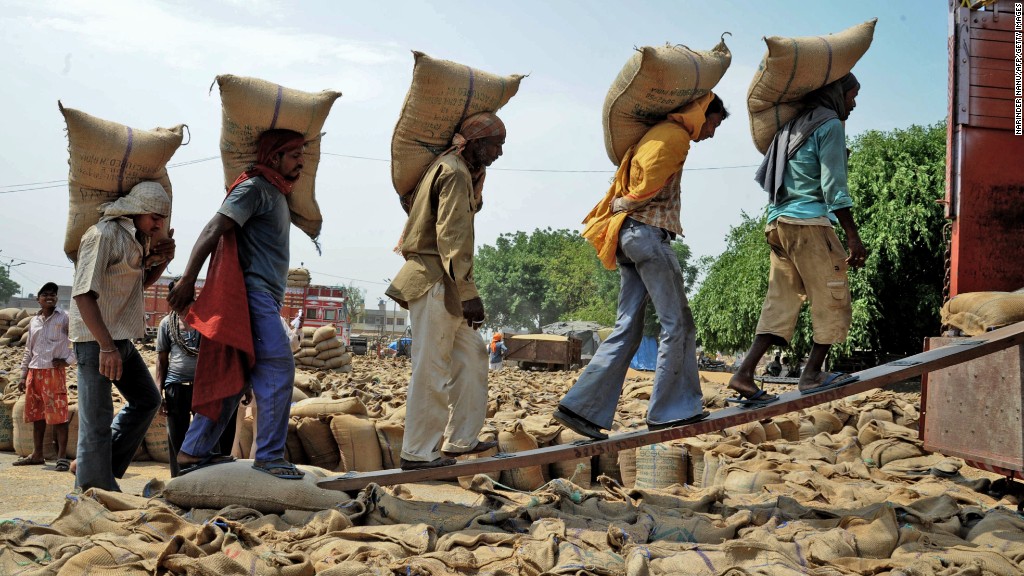
It's been a rough start to 2016.
China is clearly slowing down; the World Bank is projecting that economies like Brazil and Russia -- much vaunted in the early 2000s -- will shrink this year; oil prices continue to trawl lows. It's no surprise, then, that global markets seem spooked: U.S. stocks have suffered their worst ever start to a year, with markets across Europe, Africa, and Asia tracking similar declines.
India's stock market has caught some of the jitters, too. But if you look at the macro environment, India seems like a rare good spot in a tough neighborhood. Inflation has been tamed, the rupee is stable, and Indian GDP growth is motoring along at 7% a year, making it the world's fastest growing major economy. Indeed, as Indian Finance Minister Arun Jaitley pointed out at the World Economic Forum in Davos last month, India has been one of the few major economies to defy global slowdowns in 2001, 2008, and 2015.
Related: India bucks global trend with 7.3% growth
You can give some credit to India's governments during those years, but there are also other broader reasons why India booms while other parts of the world struggle.
First, India is starting from a far, far lower base than its peers. Put simply, at an average income of $1,500 a year, its people have more room to grow. (The average income in China is $7,000; in the U.S. it's $53,000).
Second, India at this moment is demographically blessed. With 600 million people under the age of 27, most Indians are entering their prime earning years.
Third, and most importantly given the current global climate, there is no greater beneficiary from cheap oil prices than India, one of the world's largest and fastest-growing net importers of fuel. With oil trading at one-fifth its record highs -- below $30 a barrel -- India has been able to curb its deficit, cut ruinous subsidies and contemplate the big infrastructure projects it so badly needs.
Those are the obvious tailwinds.
When you look closer, there's more afoot. India is uniquely positioned to benefit from a remarkable confluence of global trends.
Consider energy. Developed economies have already spent hundreds of billions of dollars investing in an entire ecosystem of reliable electricity for their citizens. India is nowhere near that point. Millions of Indians live in villages that remain off the grid. Given India's limited resources, and the sheer number of people demanding electricity, it is only natural for India to turn to coal -- the cheapest yet dirtiest source of energy. Enter: luck and good timing. Right at the point where India needs to double its energy output in the next 15 years, solar energy costs are reaching "grid parity" with coal. Put simply, for the first time in the history of the world, technological advances mean that a nation can set up solar plants in a cost-effective manner. And solar is going to get cheaper and cheaper.
Call it a "last-mover" advantage.
You can draw a parallel with India's pioneering biometric identification system. Unlike say, the United States, which has given every citizen a social security number, India had no such mass public records system. Instead of trying to create a simple database and follow the U.S., India is in the process of leapfrogging straight to a fully biometric system, the benefits of which will begin to be unleashed over the next few decades on a number of fronts from banking and health care to payments and pensions.
Related: 5 stunning facts about India's railways
Or consider the Internet and smart phones. While the developed world evolved from dial up Internet to cable, broadband, WiFi, and then finally 4G on a smart device, many Indians are diving straight into a revolution -- they are discovering the Internet on cheap and high speed smart phones.
India's last-mover advantage could be applied to many industries: health care, pharmaceuticals, banking, travel, retail. The R&D has been done elsewhere, but thanks to a confluence of size, development patterns, and timing, India stands to benefit in a mass way unimagined in the history of the world. No other century could provide a similar last-mover advantage for so many people; technology has never boomed so quickly, and the world has never been this globalized.
That's the rosy picture.
It could so easily not turn out that way. There will be hurdles, global crises, competing nations. There could be good old fashioned bungling on India's part, the likes of which have doused out a number of false Indian summers. One can also argue that tech-optimists have oversold the degree to which new innovations can harness future growth. Maybe being a last-mover can turn out to be just what it sounds like: being last.
Related: India's accelerating growth revs up car sales
That's why it's important for thought leaders and planners in India and across Asia to not get complacent. India has much to achieve and get right. Its basic infrastructure -- on roads, bridges, buildings -- remains abysmal. The World Economic Forum's global competitiveness index puts India at 81st in the world for basic infrastructure. Other indicators are just as worrying: 84th for health and primary education, 91st for its goods market, 103rd for its labor market, and a shocking 120th for technological readiness. All of those ground conditions make India ripe for worry -- but also ripe for a revolution. What is needed is bold ideas, investment, and execution.
With that backdrop, is there a more exciting topic to discuss than India, in the context of Asia and the world? That's exactly what we plan to do on February 14th in Mumbai at the CNN Asia Business Forum with a number of top global thinkers, CEOs, and leaders.


